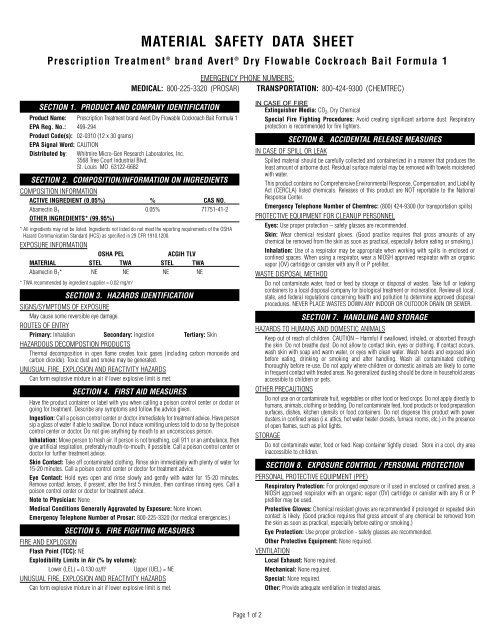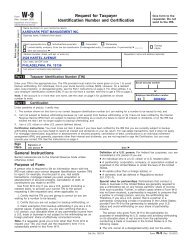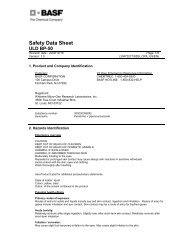Avert Dry Flowable Cockroach Bait MSDS - Do My Own Pest Control
Avert Dry Flowable Cockroach Bait MSDS - Do My Own Pest Control
Avert Dry Flowable Cockroach Bait MSDS - Do My Own Pest Control
Create successful ePaper yourself
Turn your PDF publications into a flip-book with our unique Google optimized e-Paper software.
MATERIAL SAFETY DATA SHEET<br />
Prescription Treatment ® brand <strong>Avert</strong> ® <strong>Dry</strong> <strong>Flowable</strong> <strong>Cockroach</strong> <strong>Bait</strong> Formula 1<br />
EMERGENCY PHONE NUMBERS:<br />
MEDICAL: 800-225-3320 (PROSAR) TRANSPORTATION: 800-424-9300 (CHEMTREC)<br />
SECTION 1. PRODUCT AND COMPANY IDENTIFICATION<br />
Product Name: Prescription Treatment brand <strong>Avert</strong> <strong>Dry</strong> <strong>Flowable</strong> <strong>Cockroach</strong> <strong>Bait</strong> Formula 1<br />
EPA Reg. No.: 499-294<br />
Product Code(s): 02-0310 (12 x 30 grams)<br />
EPA Signal Word: CAUTION<br />
Distributed by: Whitmire Micro-Gen Research Laboratories, Inc.<br />
3568 Tree Court Industrial Blvd.<br />
St. Louis MO 63122-6682<br />
SECTION 2. COMPOSITION/INFORMATION ON INGREDIENTS<br />
COMPOSITION INFORMATION<br />
ACTIVE INGREDIENT (0.05%) % CAS NO.<br />
Abamectin B 1 0.05% 71751-41-2<br />
OTHER INGREDIENTS* (99.95%)<br />
* All ingredients may not be listed. Ingredients not listed do not meet the reporting requirements of the OSHA<br />
Hazard Communication Standard (HCS) as specified in 29 CFR 1910.1200.<br />
EXPOSURE INFORMATION<br />
OSHA PEL<br />
ACGIH TLV<br />
MATERIAL STEL TWA STEL TWA<br />
Abamectin B 1 * NE NE NE NE<br />
* TWA recommended by ingredient supplier = 0.02 mg/m 3<br />
SECTION 3. HAZARDS IDENTIFICATION<br />
SIGNS/SYMPTOMS OF EXPOSURE<br />
May cause some reversible eye damage.<br />
ROUTES OF ENTRY<br />
Primary: Inhalation Secondary: Ingestion Tertiary: Skin<br />
HAZARDOUS DECOMPOSTION PRODUCTS<br />
Thermal decomposition in open flame creates toxic gases (including carbon monoxide and<br />
carbon dioxide). Toxic dust and smoke may be generated.<br />
UNUSUAL FIRE, EXPLOSION AND REACTIVITY HAZARDS<br />
Can form explosive mixture in air if lower explosive limit is met.<br />
SECTION 4. FIRST AID MEASURES<br />
Have the product container or label with you when calling a poison control center or doctor or<br />
going for treatment. Describe any symptoms and follow the advice given.<br />
Ingestion: Call a poison control center or doctor immediately for treatment advice. Have person<br />
sip a glass of water if able to swallow. <strong>Do</strong> not induce vomiting unless told to do so by the poison<br />
control center or doctor. <strong>Do</strong> not give anything by mouth to an unconscious person.<br />
Inhalation: Move person to fresh air. If person is not breathing, call 911 or an ambulance, then<br />
give artificial respiration, preferably mouth-to-mouth, if possible. Call a poison control center or<br />
doctor for further treatment advice.<br />
Skin Contact: Take off contaminated clothing. Rinse skin immediately with plenty of water for<br />
15-20 minutes. Call a poison control center or doctor for treatment advice.<br />
Eye Contact: Hold eyes open and rinse slowly and gently with water for 15-20 minutes.<br />
Remove contact lenses, if present, after the first 5 minutes, then continue rinsing eyes. Call a<br />
poison control center or doctor for treatment advice.<br />
Note to Physician: None<br />
Medical Conditions Generally Aggravated by Exposure: None known.<br />
Emergency Telephone Number of Prosar: 800-225-3320 (for medical emergencies.)<br />
SECTION 5. FIRE FIGHTING MEASURES<br />
FIRE AND EXPLOSION<br />
Flash Point (TCC): NE<br />
Explodibility Limits in Air (% by volume):<br />
Lower (LEL) = 0.130 oz/ft 3 Upper (UEL) = NE<br />
UNUSUAL FIRE, EXPLOSION AND REACTIVITY HAZARDS<br />
Can form explosive mixture in air if lower explosive limit is met.<br />
IN CASE OF FIRE<br />
Extinguisher Media: CO 2 , <strong>Dry</strong> Chemical<br />
Special Fire Fighting Procedures: Avoid creating significant airborne dust. Respiratory<br />
protection is recommended for fire fighters.<br />
SECTION 6. ACCIDENTAL RELEASE MEASURES<br />
IN CASE OF SPILL OR LEAK<br />
Spilled material should be carefully collected and containerized in a manner that produces the<br />
least amount of airborne dust. Residual surface material may be removed with towels moistened<br />
with water.<br />
This product contains no Comprehensive Environmental Response, Compensation, and Liability<br />
Act (CERCLA) listed chemicals. Releases of this product are NOT reportable to the National<br />
Response Center.<br />
Emergency Telephone Number of Chemtrec: (800) 424-9300 (for transportation spills)<br />
PROTECTIVE EQUIPMENT FOR CLEANUP PERSONNEL<br />
Eyes: Use proper protection – safety glasses are recommended.<br />
Skin: Wear chemical resistant gloves. (Good practice requires that gross amounts of any<br />
chemical be removed from the skin as soon as practical, especially before eating or smoking.)<br />
Inhalation: Use of a respirator may be appropriate when working with spills in enclosed or<br />
confined spaces. When using a respirator, wear a NIOSH approved respirator with an organic<br />
vapor (OV) cartridge or canister with any R or P prefilter.<br />
WASTE DISPOSAL METHOD<br />
<strong>Do</strong> not contaminate water, food or feed by storage or disposal of wastes. Take full or leaking<br />
containers to a local disposal company for biological treatment or incineration. Review all local,<br />
state, and federal regulations concerning health and pollution to determine approved disposal<br />
procedures. NEVER PLACE WASTES DOWN ANY INDOOR OR OUTDOOR DRAIN OR SEWER.<br />
SECTION 7. HANDLING AND STORAGE<br />
HAZARDS TO HUMANS AND DOMESTIC ANIMALS<br />
Keep out of reach of children. CAUTION – Harmful if swallowed, inhaled, or absorbed through<br />
the skin. <strong>Do</strong> not breathe dust. <strong>Do</strong> not allow to contact skin, eyes or clothing. If contact occurs,<br />
wash skin with soap and warm water, or eyes with clean water. Wash hands and exposed skin<br />
before eating, drinking or smoking and after handling. Wash all contaminated clothing<br />
thoroughly before re-use. <strong>Do</strong> not apply where children or domestic animals are likely to come<br />
in frequent contact with treated areas. No generalized dusting should be done in household areas<br />
accessible to children or pets.<br />
OTHER PRECAUTIONS<br />
<strong>Do</strong> not use on or contaminate fruit, vegetables or other food or feed crops. <strong>Do</strong> not apply directly to<br />
humans, animals, clothing or bedding. <strong>Do</strong> not contaminate feed, food products or food preparation<br />
surfaces, dishes, kitchen utensils or food containers. <strong>Do</strong> not dispense this product with power<br />
dusters in confined areas (i.e. attics, hot water heater closets, furnace rooms, etc.) in the presence<br />
of open flames, such as pilot lights.<br />
STORAGE<br />
<strong>Do</strong> not contaminate water, food or feed. Keep container tightly closed. Store in a cool, dry area<br />
inaccessible to children.<br />
SECTION 8. EXPOSURE CONTROL / PERSONAL PROTECTION<br />
PERSONAL PROTECTIVE EQUIPMENT (PPE)<br />
Respiratory Protection: For prolonged exposure or if used in enclosed or confined areas, a<br />
NIOSH approved respirator with an organic vapor (OV) cartridge or canister with any R or P<br />
prefilter may be used.<br />
Protective Gloves: Chemical resistant gloves are recommended if prolonged or repeated skin<br />
contact is likely. (Good practice requires that gross amount of any chemical be removed from<br />
the skin as soon as practical, especially before eating or smoking.)<br />
Eye Protection: Use proper protection - safety glasses are recommended.<br />
Other Protective Equipment: None required.<br />
VENTILATION<br />
Local Exhaust: None required.<br />
Mechanical: None required.<br />
Special: None required.<br />
Other: Provide adequate ventilation in treated areas.<br />
Page 1 of 2
MATERIAL SAFETY DATA SHEET<br />
Prescription Treatment ® brand <strong>Avert</strong> ® <strong>Dry</strong> <strong>Flowable</strong> <strong>Cockroach</strong> <strong>Bait</strong> Formula 1<br />
SECTION 9. PHYSICAL AND CHEMICAL PROPERTIES<br />
Appearance: Brown dust<br />
Odor: Mild odor<br />
Solubility in Water: Insoluble<br />
Vapor Pressure: NA<br />
Viscosity: NA<br />
Vapor Density: NE<br />
Boiling Point: NE<br />
Freezing/Melting Point: NE<br />
pH: NA Density: 42 lbs/ft 3<br />
SECTION 10. STABILITY AND REACTIVITY<br />
REACTIVITY<br />
Stability: Indefinite when used according to label directed.<br />
Conditions to Avoid: None known.<br />
Incompatibility (Material to Avoid): Abamectin can be hydrolyzed by strong, caustic<br />
solutions.<br />
Hazardous Polymerization: Will not occur.<br />
HAZARDOUS DECOMPOSITION PRODUCTS<br />
Thermal decomposition in open flame creates toxic gases (including carbon monoxide and<br />
carbon dioxide). Toxic dust and smoke may be generated.<br />
SECTION 11. TOXICOLOGICAL INFORMATION<br />
ROUTES OF ENTRY<br />
Primary: Inhalation Secondary: Ingestion Tertiary: Skin<br />
ACUTE<br />
Eyes: May cause some reversible eye irritation. Product produced slight conjunctival eye<br />
irritation in albino rabbit eyes reversible within seven days. Caused a dull cornea in albino rabbit<br />
eyes, reversible in three days.<br />
Skin: Non-irritating to skin. Acute dermal LD 50 > 2,000 mg/kg (rabbits). Primary skin irritation<br />
index = 0.00 (rabbits). Product is not a sensitizer when tested on guinea pigs.<br />
Ingestion: Acute oral toxicity LD 50 > 5,000 mg/kg (rats).<br />
Inhalation: Particle size greatly reduces the possibility of inhalation.<br />
CHRONIC / CARCINOGENICITY<br />
Neither this product nor any of its ingredients are classified as carcinogens by the National<br />
Toxicity Program (NTP), the International Agency for Research on Cancer (IARC) or the<br />
Occupational Safety and Health Administration (OSHA).<br />
SECTION 12. ECOLOGICAL INFORMATION<br />
This pesticide is toxic to fish and wildlife. <strong>Do</strong> not apply directly to water. <strong>Do</strong> not contaminate water<br />
by cleaning of equipment or disposal of equipment washwaters. This product is highly toxic to<br />
bees exposed to direct treatment of residues on blooming crops or weeds. <strong>Do</strong> not apply this<br />
product or allow it to drift to blooming crops or weeds if bees are visiting the treatment areas.<br />
SECTION 13. DISPOSAL CONSIDERATION<br />
<strong>Do</strong> not contaminate water, food or feed by disposal of container or waste. Dispose of container<br />
in accordance with all Federal, state and local regulations.<br />
Container Disposal: Empty container by using the product according to the label directions.<br />
<strong>Do</strong> not reuse this container! Offer empty container for recycling, if available, or place in trash if<br />
allowed by state and local regulations. If container is partly full, contact your local solid waste<br />
agency or call 1-800-CLEANUP for disposal instructions.<br />
Waste Disposal: Wastes resulting from the use of this product may be disposed of on site or<br />
at an approved waste disposal facility. NEVER PLACE UNUSED PRODUCT DOWN ANY INDOOR<br />
OR OUTDOOR DRAIN!<br />
SECTION 14. TRANSPORT INFORMATION<br />
This product is not regulated for transportation via any mode of transportation.<br />
SECTION 15. REGULATORY INFORMATION<br />
CERCLA<br />
This product contains no CERCLA listed chemicals.<br />
SARA TITLE III SECTION 311/312 HAZARD CLASS<br />
This product has been reviewed according to the EPA “Hazard Categories” promulgated under<br />
Section 311 and 312 of the Superfund Amendment and Reauthorization Act of 1986 (SARA Title<br />
III) and is considered, under applicable definitions, to meet the following categories:<br />
Immediate Health Hazard<br />
SARA TITLE III SECTION 313 CHEMICALS<br />
This product contains no substances subject to the reporting requirements of Section 313 of the<br />
Superfund Amendments and Reauthorization Act of 1986 (SARA Title III) or 40 CFR Part 372 in<br />
concentrations above the de minimis concentration level.<br />
TSCA<br />
All components of this product are listed or excluded from listing on the US Toxic Substance<br />
<strong>Control</strong> Act (TSCA) Chemical Substance Inventory.<br />
SECTION 16. OTHER INFORMATION<br />
NFPA HEALTH RATING INFORMATION<br />
HEALTH - 1 FLAMMABILITY – 0 REACTIVITY - 1<br />
HMIS HAZARD RATING SYSTEM<br />
HEALTH - 1 FLAMMABILITY – 0 REACTIVITY - 1<br />
KEY:<br />
4 = Severe<br />
3 = Serious<br />
2 = Moderate<br />
1 = Slight<br />
0 = Minimal<br />
The information and recommendations contained herein are based upon data believed to be correct. However, no guarantee or warranty of any kind, expressed or implied, is made<br />
with respect to the information contained herein. For automatic <strong>MSDS</strong> updates, register at www.wmmg.com.<br />
Questions concerning the safe handling of the product should be referred to the Whitmire Micro-Gen customer service department at 800-777-8570.<br />
NA - Not Applicable Effective Date: 9/30/05<br />
NE - Not Established Review Date: 9/30/05<br />
PEL - Permissible Exposure Limit Supersedes: 12/10/03<br />
TLV - Threshold Limit Value Text ID: 051117-4<br />
STEL - Short Term Exposure Limit (15 min.) Code #: 069-014<br />
TWA - Time Weighted Average (8 hrs.) WMG Part No: 19-0733-02<br />
Page 2 of 2







